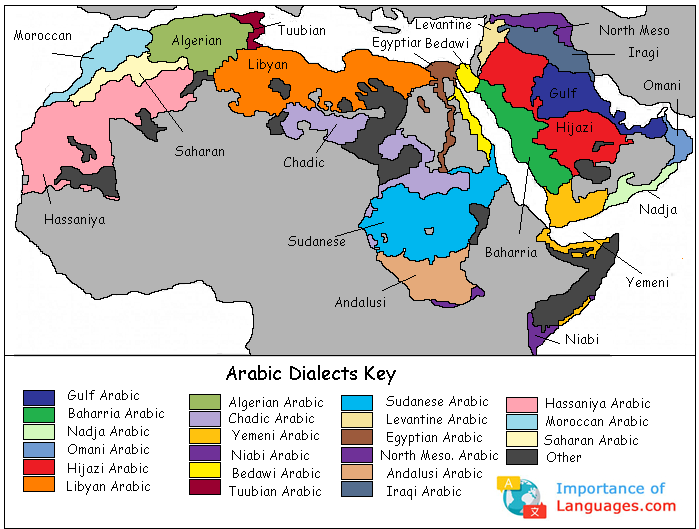Within any language or language group there may be significant changes in speech, vocabulary, and pronunciation. The term used to describe these changes is called a dialect. Some words or phrases that exist in one dialect may exist or be absent from different dialect. The common dialect in Arabic language is called Modern Standard Arabic (MSA). This dialect is understood or spoken as a second dialect by more than 206 million Arabic-speaking people. MSA is spoken in most formal situations, such as radio broadcasts, lectures and sermons, since it’s one of the most commonly understood Arabic dialects.
Arabic Dialects Map

Arabic Dialects List
- Sudanese Arabic – Mostly spoken in the Sudan
- Levantine Arabic – This dialect is often heard in Syria, Lebanon, Palestine, and western Jordan
- Gulf Arabic – Mostly heard throughout the Gulf Coast from Kuwait to Oman
- Najdi Arabic – This dialect is most often heard in the desert and oasis areas of central Saudi Arabia
- Yemeni Arabic – This dialect is most common to Yemen
- Iraqi Arabic – The dialect most commonly spoken in Iraq
- Hijazi Arabic – This dialect is spoken in the area west of present-day Saudi Arabia, which is referred to as the Hejaz region.
- Egyptian Arabic – This is considered the most widely spoken and understood “second dialect.” It’s mostly heard in Egypt
- Maghreb Arabic – Spoken mostly in Algeria, Tunis, Morocco, and western Libya
- Hassaniiya Arabic – Most often spoken in Mauritania
- Andalusi Arabic – This dialect of the Arabic language is now extinct, but it still holds an important place in literary history.
- Maltese Arabic – This form of Arabic dialect is most often found in Malta.
Different Arabic dialects of the Arabic language are spoken in many different nations and regions around northern Africa and the Middle Eastern nations. However, in many areas, the differences in regional dialects may make one Arabic speaker nearly incomprehensible to another. In most cases, the different dialects don’t have a specific written form of the language, but there’s usually a certain amount of literature that accompanies each dialect, including poetry and plays. This is especially true for the dialects spoken in Egypt and Lebanon.
Interested in further study into Arabic or confused on where to start? I recommend reading our Arabic Beginners Guide

Certainly a very interesting map that was not answered by the European powers that passed through this region in the last few centuries. Another interesting map would be of the many, many tribes that are spread over those straight lines drawn through the deserts and most of Africa. A sample can be seen here: https://reliefweb.int/map/iraq/tribes-iraq
Great job
I do not know if Ethnologue.com is valid. They are a commercial firm earning from subscriptions. They say their data comes from SIL International. Your map is not wrong, but not complete. It is just an image on the screen. I have been mapping populations for more than 50 years now. For the Internet Foundation, I am looking at “all languages” on the Internet to see about streamlining (more efficient, not throwing anything away), (empowering, not eliminating). You have most likely looked at groups and individuals on the Internet who study languages, offer language services and try to make money from it, even as advocates. “language” ranks with “food”, “nutrition”, “conflict”, “environment”, “clean air and water”. There are about 5.2 Billion humans using the Internet and 8.1 Billion overall. Those missing Billions might be where there are no computers, and where written languages and permanent records are scarce. I do not know. I am just trying to understand. Paper is expensive and usually obsolete when printed, and cell phones and devices commodities, but not cheap because of manipulations. Humans can live without Internet, but in a greedy world, my guess would be they will be eliminated over time by those who do. Because systems grow and have no conscience now.
Filed as (Will the digital divide be eliminated by eliminating the ones who have no Internet?)
Richard Collins, The Internet Foundation